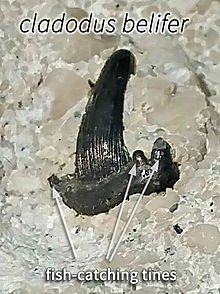Cladodus
Appearance
| Cladodus | |
|---|---|

| |
| C. belifer tooth with fish-catching tines | |
| Scientific classification | |
| Kingdom: | |
| Phylum: | |
| Class: | |
| Subclass: | |
| Order: | |
| Family: | |
| Genus: | †Cladodus Agassiz, 1843
|
| Species | |
|
See text | |
Cladodus is an extinct genus of cartilaginous fishes in the family Cladoselachidae. As the name implies, they are a type of cladodont, primitive sharks with teeth designed to snag fish and swallow them whole, instead of sawing off chunks to swallow.
Fossils of Cladodus have been found in Barkip, Scotland[1] and in the Pitkin Formation (Carboniferous period) in Arkansas, United States.
Species
- †Cladodus alternatus St. John & Worthen, 1875
- †Cladodus angulatus Newberry & Worthen, 1866
- †Cladodus bellifer St. John & Worthen, 1875
- †Cladodus divaricatus Trautschold, 1874
- †Cladodus elegans Newberry & Worthen, 1870 [2] Remains (braincase and a tooth) have been found in Scotland (Clackmannan Group).[3]
- †Cladodus eriensis Bryant, 1935
- †Cladodus formosus Hay, 1902
- †Cladodus marginatus Agassiz, 1843
- †Cladodus mirabilis Agassiz, 1843 (type species)
- †Cladodus pandatus St. John & Worthen, 1875
- †Cladodus springeri St. John & Worthen, 1875
- †Cladodus vanhornei St. John & Worthen, 1875
- †Cladodus yunnanensis Pan, 1964
See also
References
- ^ Catalogue of the western Scottish fossils (Public domain ed.). Blackie. 1876. pp. 76–. Retrieved 19 February 2012.
- ^ Comments on the selachian genus Cladodus Agassiz, 1843. Christopher J. Duffin and Michal Ginter,Journal of Vertebrate Paleontology, 2006, Volume 26, Issue 2, pages 253-266, doi:10.1671/0272-4634(2006)26[253:COTSGC2.0.CO;2]
- ^ The Braincase and Jaws of Cladodus from the Lower Carboniferous of Scotland. Michal Ginter and John G. Maisey, Palaeontology, March 2007, Volume 50, Issue 2, pages 305–322, doi:10.1111/j.1475-4983.2006.00633.x
